 |
Lotus in the fire
Unsui rules OK |
 |
This will be the final part of this little series. I hope you got an idea of my idea of the Soto idea and reality of practice.
This last part relates to practice in a formal priest seminary, the so-called sôdô-ango. I wrote about it already in the 5th article of this series called Sessa-takuma - ango as life in a rock grinder, but I did not get into the details then.
Before I start: Someone asked me to clarify what the term "rôshi" means in Rinzai and Soto.
Roshi is a term that is often aplied to Zen teachers both in Japan and the West, although it is only in the West that people suppose that it is something like an academic title that you hang on your door or print on your name card. It is not.
Literally, "roshi" means "old master". There are no minimum age requirements though.
In Rinzai Zen, it is relatively easy to say who is a roshi and who is not. Anyone who is authorized by another roshi (i.e. his teacher) is a roshi. This authorization (officially the "inka-shômei" document) is documented on a piece of paper, that is why it is also called colloquially "ichi-mai", that is "one sheet (of paper)". The transmission is totally vertical from teacher to student, no peer control is involved. That means that the Rinzai sect has no means to control who is made a roshi and who is not.
Inspite of that, the number of Rinzai roshis is relatively low, maybe around 50 or so. When I was translating for the late Keido Fukushima roshi on his trips to the USA, people would ask how long it takes to become a roshi. Although there is no curriculum, Fukushima's standard answer was: "20 years for Japanese, 25 for foreigners". He would explain that it would take 10 years to solve all the kôans (of which there are 1700, but Fukushima used to say that the number is 3000 including the sub-questions)
in the sôdô. After the student has solved all koans, he can leave the sôdô and live on his own, but he is still not considered a roshi. For this he has to complete another ten years of training, called "go-go-no-shugyô" in Japanese. Literally, this means "practice after satori/enlightenment", but Fukushima preferred the translation "special practice". Fukushima would explain taht the student builds up a "religious personality" during this decade. I would say it is a kind of period that functions to test if the student is actually able to live in regular society and apply his koan understanding to daily life, after he has lived in an environment that can be quite surreal and detached from the lives of the rest of humanity. Usually, the student lives in small parish temple during this decade, not in a formal training monastery.
Of course, ten years are only a rule of thumb for both the first and the second half of the training, some students are faster, some are slower. Some teachers are stricter, some are more easy. Fukushima said that the extra five years for foreigners are needed to master ancient Japanese and Chinese, in which the poems are written that function as jakugo for the koans. After solving a koan, the student often has to look up poems in a collection called "zenrin-kushû". For this, he needs the ancient language skills. There is an English translation called "Zen Forest", but it is not complete (has about half of the material only).
Although there is an objective criterium about who is a roshi, i.e. the sheet of paper, it is considered very bad style even in Rinzai Zen to call yourself a "roshi". Even the more in Soto, where there is no such objective criterium.
Shihô, i.e. dharma transmission is objectively documented on paper in Soto as well, but dharma transmission does not make you a roshi. And even if it did, it would not be something special, as there are more than 15.000 people with Soto dharma transmission in Japan only. How you can get it is explained in this series of articles, it can take more than a decade, but if you find an easy master, you can get it in a few years, without any language skills, even without much training. In Soto, basically anyone can be called a roshi, but again, you do not call yourself a roshi. And if you did, it would not mean much, except that you are stupid.
What might come closest to a Rinzai roshi in Soto is a shike. There are about 50 or so of these in Soto (the Rinzai roshis can also be adressed as "shike"). One big difference between the rinzai roshi and the Soto shike is that the shike transmission (it is not called that way, but I will call it so for convenience) is not vertical at all. That means that even if your teacher is a shike, he can not appoint you as a shike. So who does appoint a shike? In fact, there is a kind of commitee, called the "shike-kai", consisting of all Japanese Soto shike. There is no foreign shike, as far as i know. The shike-kai can appoint anyone as a shike whom they condider their equal, i.e. who has done genuine training and study, cultivated himself and reached whatever understanding that might be considered enlightened enough to match the enlightenment of the other shike. So shike appointment can be called horizontal in a way. In reality of course, the criteria for becoming a shike are less practice and attainment than currying favor with the rest of the shike. Often, this means demonstrating one's determination through practicing dana (donation) to the shike-kai, inviting them to drinks etc. Is sex also involved in this horizontal transmission, you ask? Who am I to know?
But now to the unsui part of the article, who cares about roshis anyway? An unsui is a training monk. There are a few monasteries like Antaiji where you can train without being part of one of the official seminaries, but usually an unsui will list up at one of those either right after ordination or at least a few years after he has ordained. It is important to keep in mind that - contrary to what many in the West might believe, you have to ordain first to enter the seminary, not the other way around. Actually, you need the approval of your ordination master to enter (and leave) the seminary, so without ordination, there is usually no way in. Where do people ordain then? Usually at one of the 15.000 parish temples throughout Japan.
Below there is a map that shows the location of the 30 or so official priest seminaries in Japanese Soto. You can find them listed up on the Japanese "Soto-shu" Wikipedia page as well. Some have links to their own homepages.
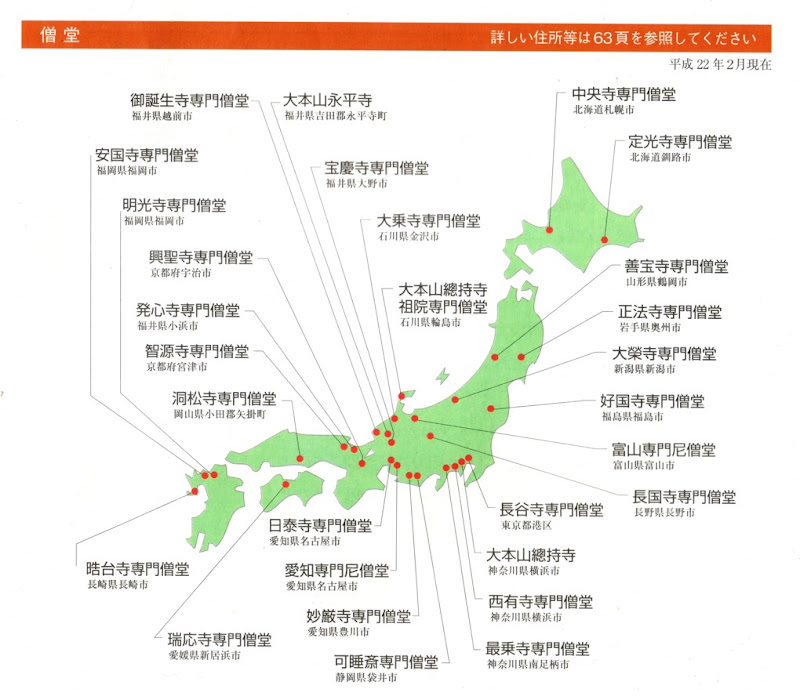
The following are copies of a manga style unsui manual that I received when I was doing ango at Hosshinji about 15 years ago. One of the Japanese monks did these iluustrations. Like all Japanese manga, you read them from the top right to the bottom left. First, when you arrive at the monastery entrance, you hit the wooden board ("moppan").


Interesting that as often in Japan, you do not state your real intention up front, but attach it to something else, which turns out completely irrelevant to the real issue. What the monk says is literally: "I would like to pay respects to the founder of the monastery, and also, please give me permission to train at the seminary"
What follows depends a lot on the monastery and seniour monks you are dealing with. In Eiheiji, they might let you wait in the snow the whole day. In Hosshinji, it was not so bad. Eventually, they ask you to enter. as anywhere in Japan, before you enetr you have to take off your foot wear:


You are still not officially accepted into the monastery of course. Usually you are heading to the tanga-ryô for a week or so, where you practice either solitarily or with the other new comers that arrived during the same week. The following picture describes how you pack the kesa-bunko that travelling monks used to transport their robes and bowls in. It is not used in Japan anymore, except on the occasion of a monk formally entering or leaving a seminary (read pictures from right to left):

The next couple of days, you spend mostly doing zazen in your room, or being yelled at by the senior monks that want to test your determination. You also take part in the temple cleaning in the morning, but during this test period you do not wear your work clothes (samu-e) as would be usual, but rather tie up you kimono with the shukin-belt. This is done only during the tanga-ryô period now, but I guess they did temple work (samu) in this fashion as well, before the samu-e where invented (they are not so old, that is why they do not have them in China or Korea).
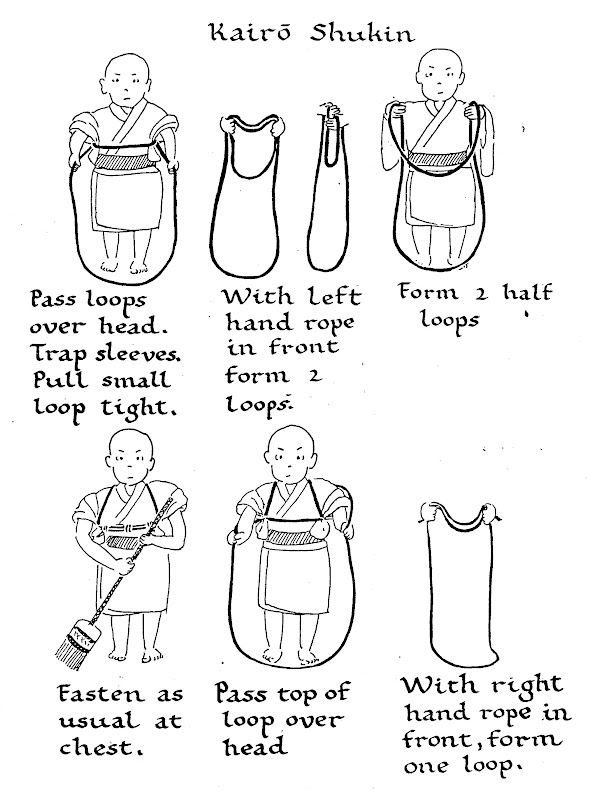
After a week or so, you will hopefully be accepted and join the senior monks in the meditaion hall (where you also sleep). This is how you get up to the platform where a plate with your name on it hangs, and how to do kinhin (walking meditation):

Sooner or later, one of the senior monks will come on patrol with the wake up stick:

Of course, time in the monastery will not only be spent in zazen, but also bowing and prostrating:
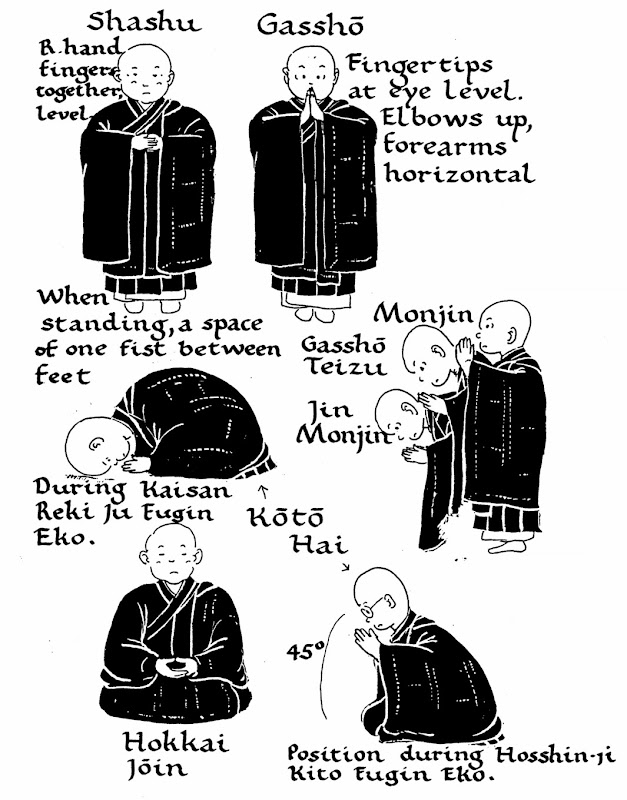

How do you put on those robes in the first place? Hard to describe in words, not so easy with pictures either, still here is the attempt to show you how to put on the shukin-belt and the o-kesa (my thoughts on the o-kesa in two old articles: Obstructed by the kesa and The meaning of the o-kesa):
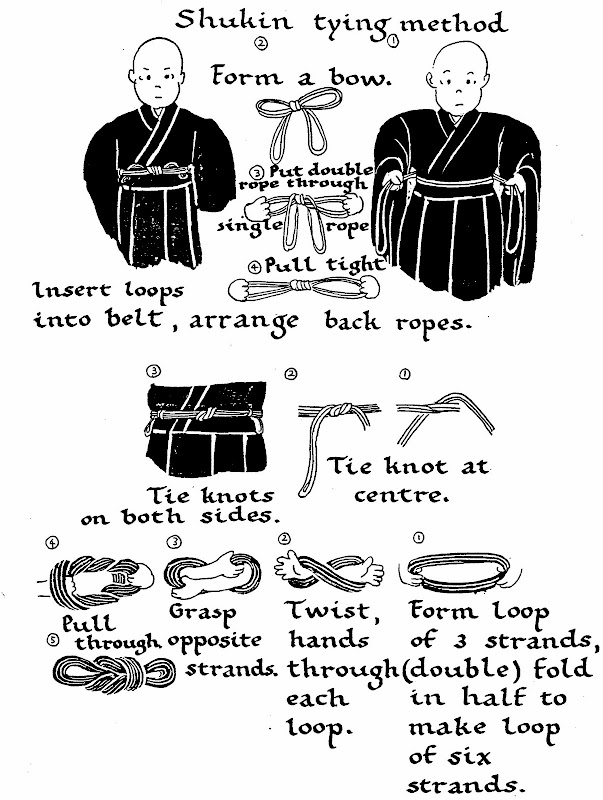
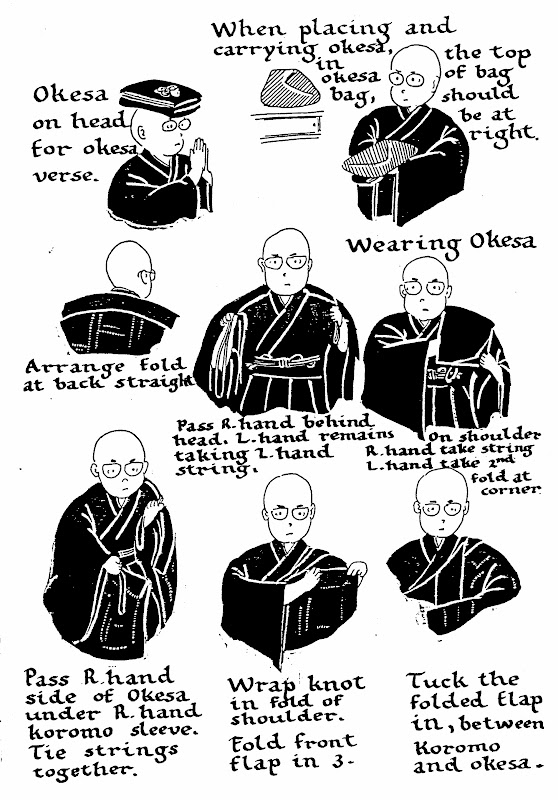
Now you also want to know how to take them off again. ShaE is the way you carry the kesa when you are not wearing it:
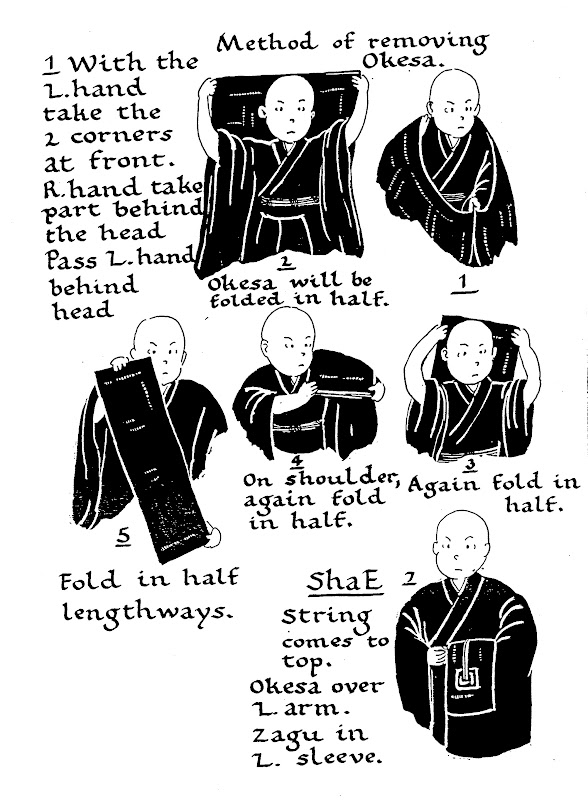
The following does not work for the so-called nyohô-e, the traditional hand sewn o-kesa that is worn in the Sawaki traditon. If you have one of the more wide spread, standard Soto kesas, you tie up the ends:
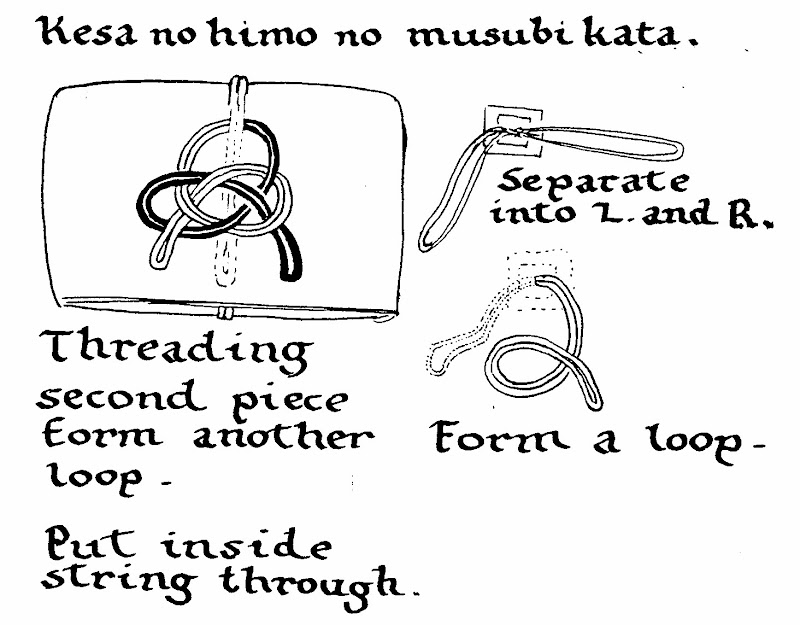
A little less complicated than the o-kesa is taking off the bib-style mini-kesa, called rakusu (not "rhaksu"!):
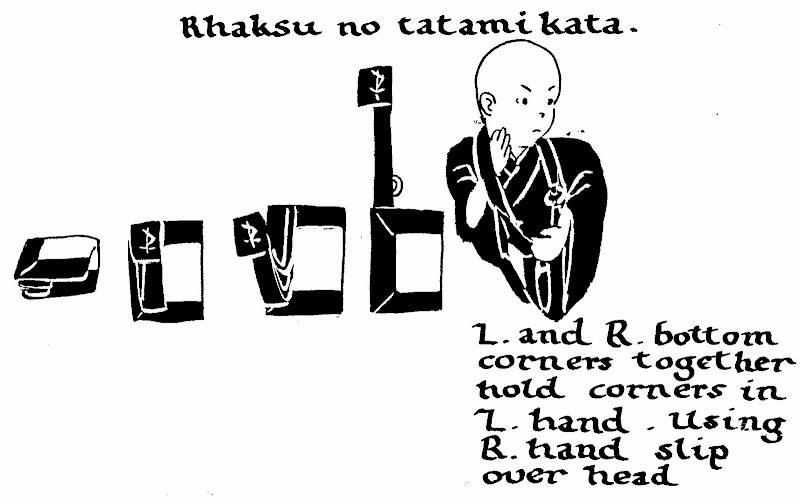
Next, how to fold the big black robe (koromo, also called dai-e) and the kimono when you store it away:
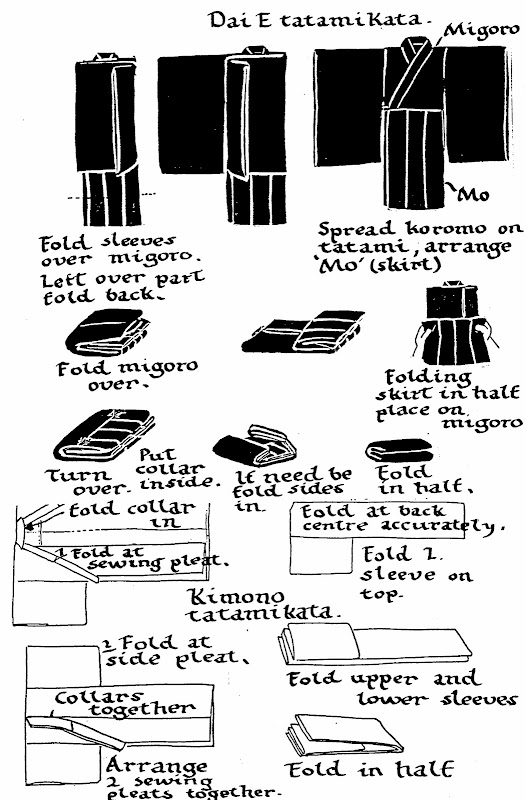
When you are in a hurry, here is an easier way to fold the dai-e:
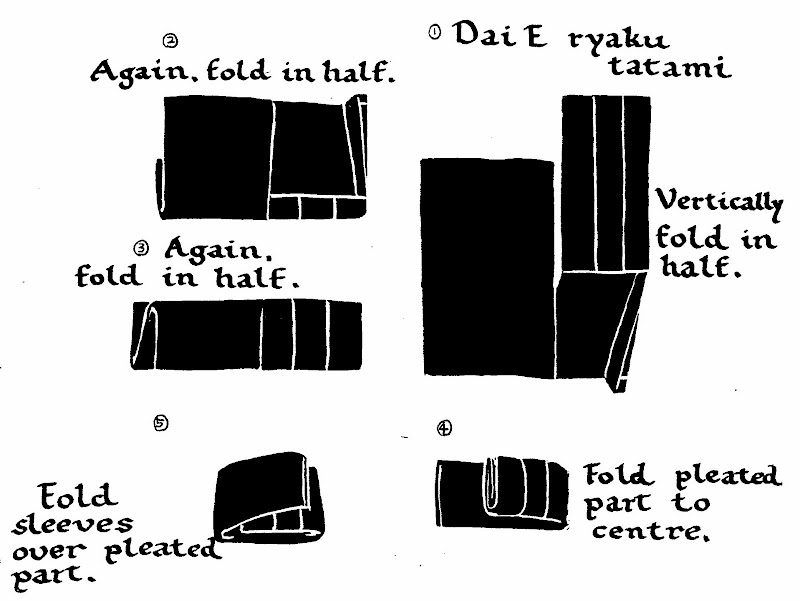
And what do you do if you want to go to the toilet during kinhin? First you take off the o-kesa, hang it on a bamboo called jôkan in front of the toilet area, next comes the robe:
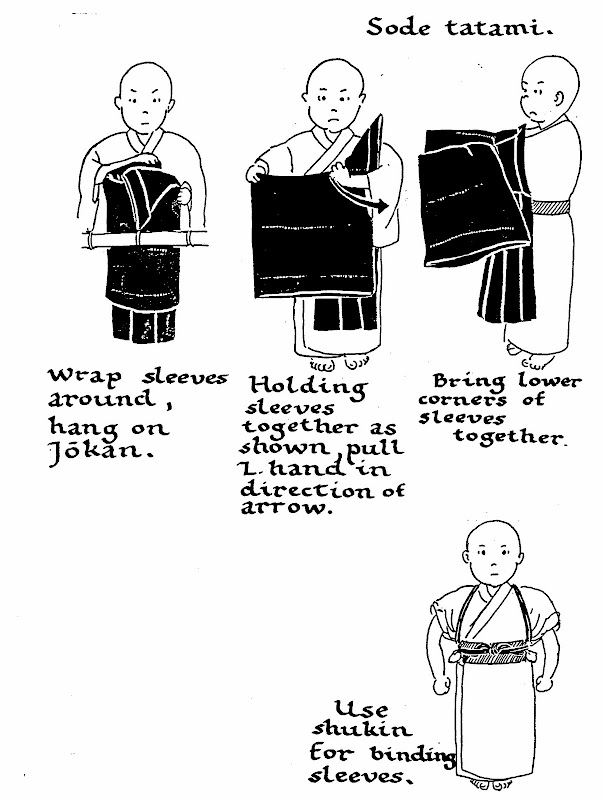
Below the kesa, dai-e and kimono you wear a traditional Japanese under garment called juban. If you can fold gthe other stuff, this one should pose no problems:
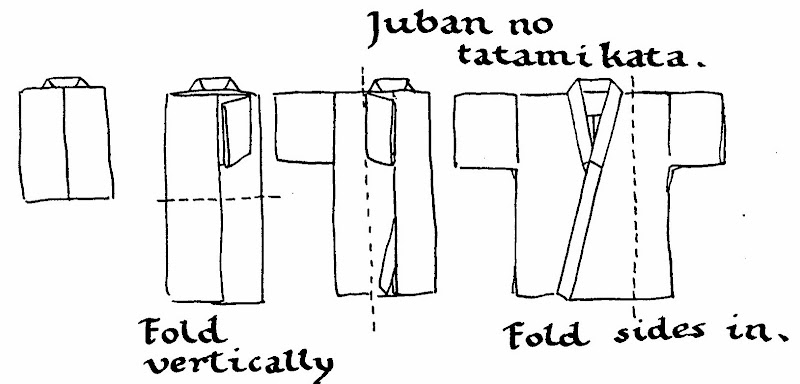
And don't forget the tabi socks, bessu and zagu:

On each day that ends with a "4" or "9" (the so called "shi-ku-nichi"), i.e. every five days, monks shave each other's heads. For this, you have to roll up your robe's sleeves.
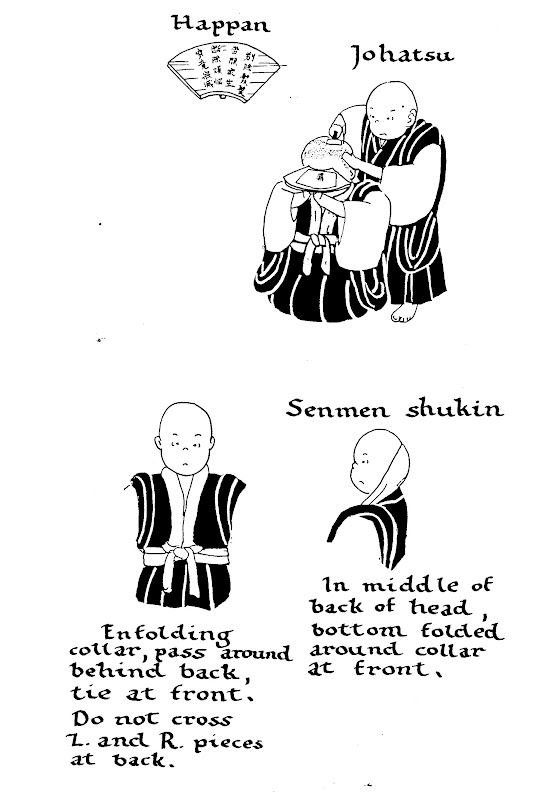
This last illustration might be intersting for lay people as well, as the way to eat with the ôyrôki-bowls (called tenpatsu) is practiced in most Japanese monasteries, and also many centres in the West, also by lay people. in Antaiji, we practice the "Ryaku Tenpatsu" style you can see in the last (bottom left) picture, kneeling in front of low tables. That is also the way we ate most of the time in Hosshinji, the rest of the picture applies only during sesshin at Hossinji (at Antaiji, we eat Ryaku Tenpatsu-style during sesshin as well):

[Muho]
| <<< Previous article | Contents | Next article >>> |
